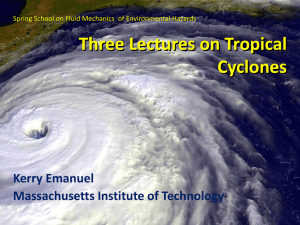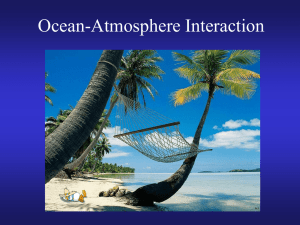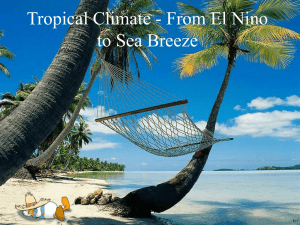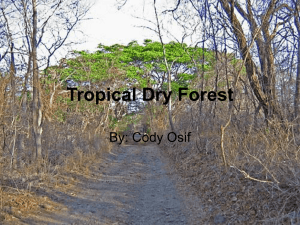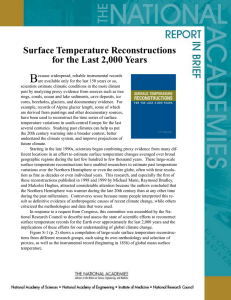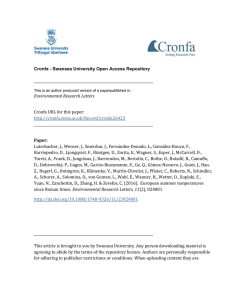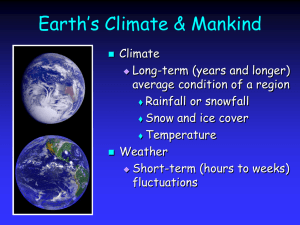Global Signatures of the `Little Ice Age` and `Medieval Climate
advertisement
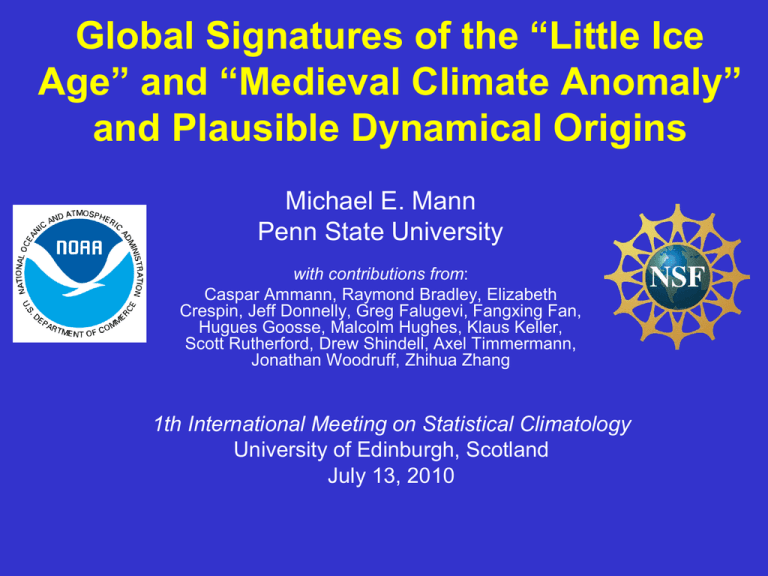
Global Signatures of the “Little Ice Age” and “Medieval Climate Anomaly” and Plausible Dynamical Origins Michael E. Mann Penn State University with contributions from: Caspar Ammann, Raymond Bradley, Elizabeth Crespin, Jeff Donnelly, Greg Falugevi, Fangxing Fan, Hugues Goosse, Malcolm Hughes, Klaus Keller, Scott Rutherford, Drew Shindell, Axel Timmermann, Jonathan Woodruff, Zhihua Zhang 1th International Meeting on Statistical Climatology University of Edinburgh, Scotland July 13, 2010 Global Surface Temperature Changes Global Surface Temperature Changes Climate “Proxy” Data… Reconstructions of Past Climate Climate “Proxy” Data… Surface Temperature Reconstructions Climate Change 2001: The Scientific Basis, Houghton, J.T., et al. (eds.), Cambridge Univ. Press, Cambridge, 2001 Surface Temperature Reconstructions Surface Temperature Reconstructions Jones, P.D., Mann, M.E., Climate Over Past Millennia, Reviews of Geophysics, 42, RG2002, doi:10.1029/2003RG000143, 2004. European Winter Cooling During the Little Ice Age Sources of Uncertainty El Nino Sources of Uncertainty El Nino How did Natural Forcings Influence influence ENSO and the Tropical Pacific During the Past Millennium? Combined response to Solar +Volcanic Forcing Ensemble mean Nino3 (100 realizations of CZ model) 40 year smooth Palymra coral isotopes (standardized to have same mean and standard deviation as Nino3 composite series) Mann, M.E., Cane, M.A., Zebiak, S.E., Clement, A., Volcanic and Solar Forcing of The Tropical Pacific Over the Past 1000 Years, Journal of Climate, 18, 447-456, 2005. How did Natural Forcings Influence influence ENSO and the Tropical Pacific During the Past Millennium? ‘Little Ice Age’ wet in Kenya: El Nino-like conditions Combined response to Solar Coral isotope +Volcanic Forcing reconstruction of past El Nino variations simulation smoothed simulation result How did Natural Forcings Influence influence ENSO and the Tropical Pacific During the Past Millennium? Cook et al, Science, ‘04 ‘Little Ice Age’ wet in southwestern U.S.: El Nino-like conditions Combined response to Solar Coral isotope +Volcanic Forcing reconstruction of past El Nino variations simulation smoothed simulation result How did Natural Forcings Influence influence ENSO and the Tropical Pacific During the Past Millennium? Cook et al, Science, ‘04 ‘Medieval Warm Period’ dry in southwestern U.S.: La Nina-like conditions Combined response to Solar Coral isotope +Volcanic Forcing reconstruction of past El Nino variations simulation smoothed simulation result Surface Temperature Reconstructions Surface Temperature Reconstructions Science (11/27/09) Surface Temperature Reconstructions Regional Time Series Applications: Atlantic Tropical Cyclones Model resolves ~50% annual variance in both calibration and split calibration/validation over 1870-2006 statistical model historical record Applications: Atlantic Tropical Cyclones Model resolves ~50% annual variance in both calibration and split calibration/validation over 1870-2006 statistical model historical record Applications: Atlantic Tropical Cyclones 95% uncertainties historical record 95% uncertainties sediments Statistical model Surface Temperature Reconstructions Science (11/27/09) Surface Temperature Reconstructions Science (11/27/09) Model-Data Comparisons Science (11/27/09) Positive Phase of Northern Annual Mode Paleoclimate Data Assimilation PROXIES MODEL Past Natural Arctic warming Paleoclimate Data Assimilation PROXIES MODEL SAT Z(800mb) Past Natural Arctic warming CONCLUSIONS •Recent hemispheric-scale warmth anomalous in at least a millennial context; can only be explained by anthropogenic radiative forcing •Prior to the 20th century, warmth and cold was highly regionally variable •Medieval warmth in high-latitude North Atlantic and parts of North America rivaled modern warmth •Reconstructed La Nina-like pattern during Medieval times, and El Ninolike anomalies during the “Little Ice Age”, suggest a ‘thermostat’ response response to natural radiative forcing •Response of Northern Annular Mode/NAO to natural volcanic and solar radiative forcing appears to explain enhanced ‘Little Ice Age’ and ‘Medieval Warm Period’ temperature signal in regions such as Europe •Combination of warm tropical Atlantic and La Nina-like conditions in the tropical Pacific can explain periods of relatively high past Atlantic Hurricane activity


